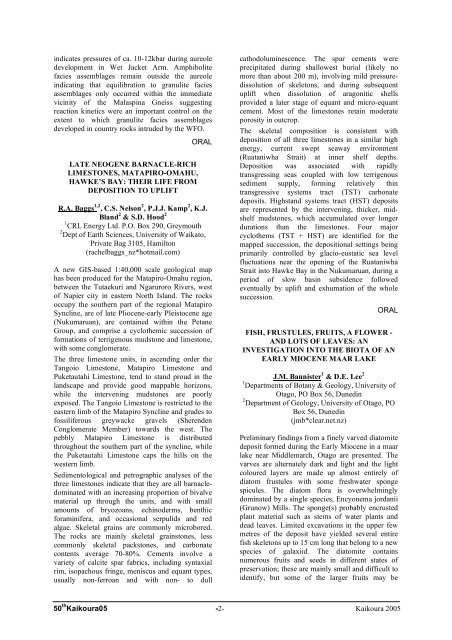50thKaikoura05 -1- Kaikoura 2005 CHARACTERISATION OF NEW ...
50thKaikoura05 -1- Kaikoura 2005 CHARACTERISATION OF NEW ...
50thKaikoura05 -1- Kaikoura 2005 CHARACTERISATION OF NEW ...
You also want an ePaper? Increase the reach of your titles
YUMPU automatically turns print PDFs into web optimized ePapers that Google loves.
indicates pressures of ca. 10-12kbar during aureole<br />
development in Wet Jacket Arm. Amphibolite<br />
facies assemblages remain outside the aureole<br />
indicating that equilibration to granulite facies<br />
assemblages only occurred within the immediate<br />
vicinity of the Malaspina Gneiss suggesting<br />
reaction kinetics were an important control on the<br />
extent to which granulite facies assemblages<br />
developed in country rocks intruded by the WFO.<br />
ORAL<br />
LATE NEOGENE BARNACLE-RICH<br />
LIMESTONES, MATAPIRO-OMAHU,<br />
HAWKE’S BAY: THEIR LIFE FROM<br />
DEPOSITION TO UPLIFT<br />
R.A. Baggs 1,2 ,C.S.Nelson 2 , P.J.J. Kamp 2 ,K.J.<br />
Bland 2 & S.D. Hood 2<br />
1 CRL Energy Ltd. P.O. Box 290, Greymouth<br />
2 Dept of Earth Sciences, University of Waikato,<br />
Private Bag 3105, Hamilton<br />
(rachelbaggs_nz*hotmail.com)<br />
A new GIS-based 1:40,000 scale geological map<br />
has been produced for the Matapiro-Omahu region,<br />
between the Tutaekuri and Ngaruroro Rivers, west<br />
of Napier city in eastern North Island. The rocks<br />
occupy the southern part of the regional Matapiro<br />
Syncline, are of late Pliocene-early Pleistocene age<br />
(Nukumaruan), are contained within the Petane<br />
Group, and comprise a cyclothemic succession of<br />
formations of terrigenous mudstone and limestone,<br />
with some conglomerate.<br />
The three limestone units, in ascending order the<br />
Tangoio Limestone, Matapiro Limestone and<br />
Puketautahi Limestone, tend to stand proud in the<br />
landscape and provide good mappable horizons,<br />
while the intervening mudstones are poorly<br />
exposed. The Tangoio Limestone is restricted to the<br />
eastern limb of the Matapiro Syncline and grades to<br />
fossiliferous greywacke gravels (Sherenden<br />
Conglomerate Member) towards the west. The<br />
pebbly Matapiro Limestone is distributed<br />
throughout the southern part of the syncline, while<br />
the Puketautahi Limestone caps the hills on the<br />
western limb.<br />
Sedimentological and petrographic analyses of the<br />
three limestones indicate that they are all barnacledominated<br />
with an increasing proportion of bivalve<br />
material up through the units, and with small<br />
amounts of bryozoans, echinoderms, benthic<br />
foraminifera, and occasional serpulids and red<br />
algae. Skeletal grains are commonly microbored.<br />
The rocks are mainly skeletal grainstones, less<br />
commonly skeletal packstones, and carbonate<br />
contents average 70-80%. Cements involve a<br />
variety of calcite spar fabrics, including syntaxial<br />
rim, isopachous fringe, meniscus and equant types,<br />
usually non-ferroan and with non- to dull<br />
cathodoluminescence. The spar cements were<br />
precipitated during shallowest burial (likely no<br />
more than about 200 m), involving mild pressuredissolution<br />
of skeletons, and during subsequent<br />
uplift when dissolution of aragonitic shells<br />
provided a later stage of equant and micro-equant<br />
cement. Most of the limestones retain moderate<br />
porosity in outcrop.<br />
The skeletal composition is consistent with<br />
deposition of all three limestones in a similar high<br />
energy, current swept seaway environment<br />
(Ruataniwha Strait) at inner shelf depths.<br />
Deposition was associated with rapidly<br />
transgressing seas coupled with low terrigenous<br />
sediment supply, forming relatively thin<br />
transgressive systems tract (TST) carbonate<br />
deposits. Highstand systems tract (HST) deposits<br />
are represented by the intervening, thicker, midshelf<br />
mudstones, which accumulated over longer<br />
durations than the limestones. Four major<br />
cyclothems (TST + HST) are identified for the<br />
mapped succession, the depositional settings being<br />
primarily controlled by glacio-eustatic sea level<br />
fluctuations near the opening of the Ruataniwha<br />
Strait into Hawke Bay in the Nukumaruan, during a<br />
period of slow basin subsidence followed<br />
eventually by uplift and exhumation of the whole<br />
succession.<br />
ORAL<br />
FISH, FRUSTULES, FRUITS, A FLOWER -<br />
AND LOTS <strong>OF</strong> LEAVES: AN<br />
INVESTIGATION INTO THE BIOTA <strong>OF</strong> AN<br />
EARLY MIOCENE MAAR LAKE<br />
J.M. Bannister 1 &D.E.Lee 2<br />
1 Departments of Botany & Geology, University of<br />
Otago, PO Box 56, Dunedin<br />
2 Department of Geology, University of Otago, PO<br />
Box 56, Dunedin<br />
(jmb*clear.net.nz)<br />
Preliminary findings from a finely varved diatomite<br />
deposit formed during the Early Miocene in a maar<br />
lake near Middlemarch, Otago are presented. The<br />
varves are alternately dark and light and the light<br />
coloured layers are made up almost entirely of<br />
diatom frustules with some freshwater sponge<br />
spicules. The diatom flora is overwhelmingly<br />
dominated by a single species, Encyonema jordanii<br />
(Grunow) Mills. The sponge(s) probably encrusted<br />
plant material such as stems of water plants and<br />
dead leaves. Limited excavations in the upper few<br />
metres of the deposit have yielded several entire<br />
fish skeletons up to 15 cm long that belong to a new<br />
species of galaxiid. The diatomite contains<br />
numerous fruits and seeds in different states of<br />
preservation; these are mainly small and difficult to<br />
identify, but some of the larger fruits may be<br />
50 th <strong>Kaikoura</strong>05 -2- <strong>Kaikoura</strong> <strong>2005</strong>















